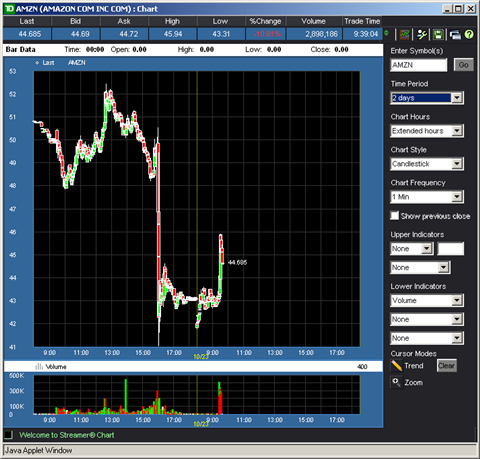E-commerce's looming question: Will consumers show up?

The fourth quarter for e-commerce will be very telling. Will online sales continue to grow even if the consumer is strapped? Or will e-commerce increasingly look like the rest of the retail sector?
To wit:
- Amazon's fourth quarter outlook, which had a range so large that you wonder why the company bothered to give guidance, indicates the company has no idea whether consumers will show up in the key holiday shopping season. Contrast Amazon's take on Wednesday with the previous quarter and the drop-off is telling. Last quarter, Amazon said its free shipping would attract consumers, who at the time were being squeezed by high gas prices. This quarter Amazon executives acknowledged that the company isn't recession proof. And comparing Amazon's growth in the last downturn--2001 to 2003--is futile since the company is bigger, incorporates more revenue levers and is diversified across multiple categories.
- GSI Commerce's third quarter results (statement) told a similar story. GSI Commerce is a company that offers e-commerce services behind the scenes of many leading retailers. GSI basically competed with Amazon's fulfillment services before Jeff Bezos & Co. ceded the market. For instance, GSI counts Toys R Us, a former Amazon partner, as a big customer along with others such as Dick's Sporting Goods and Big Lots. The upshot for GSI: The third quarter was decent relative to expectations, but the fourth quarter outlook is uncertain. It doesn't help that a key GSI customer--Linens and Things--has gone belly up.
- UPS said business slowed dramatically in September (statement). UPS and FedEx are probably the biggest e-commerce indicators. After all, that duo ships most of the packages coming from e-tailers. In its earnings statement, UPS CFO Kurt Kuehn said the company is operating "in an environment that proved substantially worse than we initially anticipated, with significant slowing toward the end of the quarter.” He added: "We anticipate a challenging environment for a number of quarters going forward. We believe the U.S. consumer will be very conservative with spending this year."
The big question is whether these fourth quarter e-commerce outlooks will turn out to be too conservative. Analysts on Thursday noted that Amazon's lower-end of its guidance is projecting a severe recession. Amazon said its fourth quarter sales will be between $6 billion and $7 billion, or up 6 percent and 23 percent from a year ago. In other words, Amazon's growth will be strong or anemic. Your guess is as good as mine as how that will turn out. Meanwhile, Wall Street doesn't like guessing games (see two day chart).

If the economy stalls further or retail price competition gets irrational over holidays, Amazon will likely react with lower prices which could lower margins further.
Big ticket items take a hit
One of the more notable comments from the Amazon conference call was that consumers are pulling back on purchases over $1,000. Amazon CFO Thomas Szkutak said on the company's conference call that the company saw "a deceleration of growth in purchase items over $1,000."Szkutak added:
Incorporated into our guidance are the order trends that we have seen to date and what we believe today to be appropriately conservative assumptions. We experienced slower rates of growth towards the end of the third quarter, coinciding with disruptions in the global financial markets. While guidance takes into account these growth rates, our results are inherently unpredictable and may be materially affected by factors, including the high level of uncertainty surrounding exchange rate fluctuations, as well as the global economy and consumer spending. It is not possible to accurately predict demand and therefore our actual results could differ materially from our guidance.
In other words, Amazon is factoring in a worst case, but really has no clue about the fourth quarter. Analysts are giving Amazon props for good execution, but note the company is at the mercy of consumers' collective pocketbook.
Cowen analyst Jim Friedland noted:
Despite Amazon’s success in driving revenue growth through expanding category breadth/depth, shipping programs such as Amazon Prime, and continued share gains with its third party merchant platform, the company is broadly exposed to the consumer and we continue to expect macro headwinds to weigh on growth.
GSI's outlook was a bit light and third quarter financial results--net loss of $12.8 million, or 27 cents a share, on revenue of $186.8 million, up 36 percent from a year ago--were roughly in line with expectations. But analysts expect some severe headwinds ahead. Oppenheimer analyst Srinivas Anantha said in a research note:
Weak volumes serve to demonstrate the profound risks of a weakening consumer and also highlight the low visibility in the business. Management lowered its top-line outlook for '08, but maintained EBITDA estimates. Given manifest weakness in volumes, we have lowered our '08-'09 revenue and adjusted EBITDA estimates, and our '08 estimates are at the low-end of guidance. We expect a weak consumer and deteriorating macro environment will remain stiff headwinds.
Other analysts were more constructive on GSI, but note the same wild card: The consumer. On the bright side, the chatter coming from e-commerce companies appears to be factoring in worse case scenarios. Anything better than Armageddon will be good news.